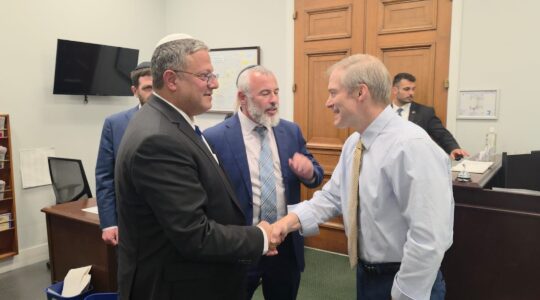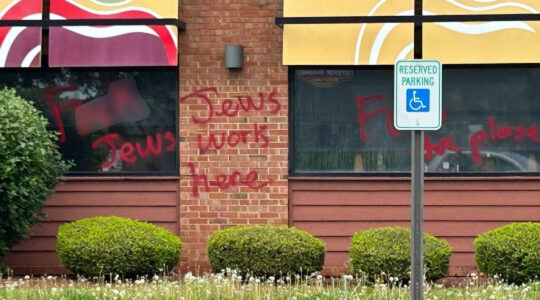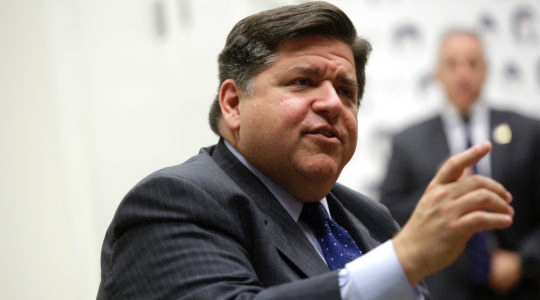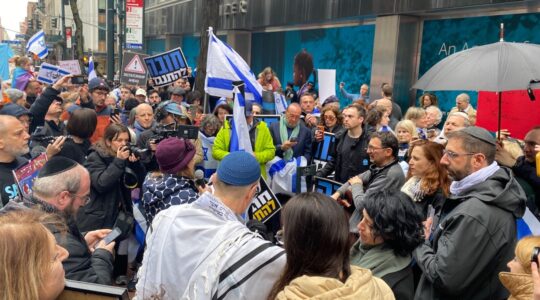
Photos of storm damage, like this one from Astoria, Queens, were shared widely on Facebook and other websites. (Peter Romano via Creative Commons)
NEW YORK (JTA) – At 10 p.m. on Monday, as the full brunt of Hurricane Sandy was bearing down on the northeastern United States, filmmaker Sandi Dubowski posted an urgent online message.
DuBowski’s elderly parents had declined to leave their home in Manhattan Beach, a neighborhood of southern Brooklyn that sits on a small peninsula flanked by the Atlantic Ocean on one side and Sheepshead Bay on the other. The neighborhood is in Zone A, low-lying areas of New York City that the mayor had ordered evacuated on Sunday afternoon in advance of the looming storm.
“The water has made it up to the first floor of the house,” Dubowski wrote. “They have gone up to the 2nd floor. Is there anyone who can rescue them and their neighbors tomorrow morning before the next high tide? I am scared how much higher it will go. Their power and phone is out.”
A flurry of messages followed, including contact information for relief organizations and city officials and simple words of prayer and encouragement. Friends reposted the appeal to their own Facebook walls to widen its circulation.
“I’m so moved,” DuBowski said Tuesday, his voice betraying the strain of the night before. “Hundreds of people were forwarding this and searching for any avenue to help. It was a harrowing night.”
Finally, early Tuesday DuBowski got a piece of good news. A neighbor with a cellphone had reached his mother, who had barely enough time to tell him she was alright before the phone went dead. DuBowski duly posted the update on Facebook.
“I know they’re alive,” he told JTA. “I hope they’re OK. I think they’re OK.”
For many trapped in New York and other northeastern cities besieged by this week’s storm, social media outlets — principally Facebook and Twitter — instantly transformed into lifelines, enabling residents to commiserate, appeal for help (or offer some) and share information, including pictures and video from the storm.
As the skies darkened Monday, video was posted showing the facade of a building in Manhattan being sheared off by the wind and of an explosion at a substation that knocked out power to most of lower Manhattan. Users linked to press conferences by the governors of New York and New Jersey, traded ideas for passing the time marooned at home in the dark, and even exchanged funny doctored photos to lighten the mood. One showed the Statue of Liberty taking cover behind her pedestal as Sandy approached.
In the wake of the storm, Facebook emerged as a vital source of information in assessing damage. A photo of a tree breaking through the roof of the Isabella Freedman Jewish Retreat Center in Connecticut, posted on Facebook on Tuesday, garnered a dozen comments in under an hour, including a link to make a donation.
But the real energy occurred as the storm was unfolding late on Monday and continued even as the power losses began in earnest, with users switching to mobile phones to keep in touch. Often, their final messages were announcements that power had been cut and they were going mobile, enabling their friends to construct virtual maps of the cascading power outages.
“I could follow, Oh I know Ivan is on 34th and 9th. OK they’re down,” said Alexis Frankel, who lives in an area of Queens that was relatively unscathed by the storm but spent hours posting dozens of storm updates. “You could follow the domino effect of how the storm was progressing, which I found particularly helpful.”
For some in less affected areas, Facebook became a means to experience what less fortunate friends were living through. “Friends in Philly were closing laptops and asking, ‘Are we in the same place?’ said Ahava Zarembski, who lives in downtown Philadelphia and never lost electricity during the storm. “All of the excitement moved to the web and what’s happening and totally not tapping into what’s happening outside.”
For a brief period, Facebook functioned in ways that critics claim it never does: bringing people together for actual, in-person socializing. At Zarembski’s house, this resulted in a pre-hurricane lunch and dance party.
“That happened because I was posting online what I’m doing, which was basically cooking and baking and telling people to come over. And they did,” she said. “People were stuck and getting cooped up. There was this weird energy and excitement, where energy meets fear. People felt the need to be together.”
JTA has documented Jewish history in real-time for over a century. Keep our journalism strong by joining us in supporting independent, award-winning reporting.





